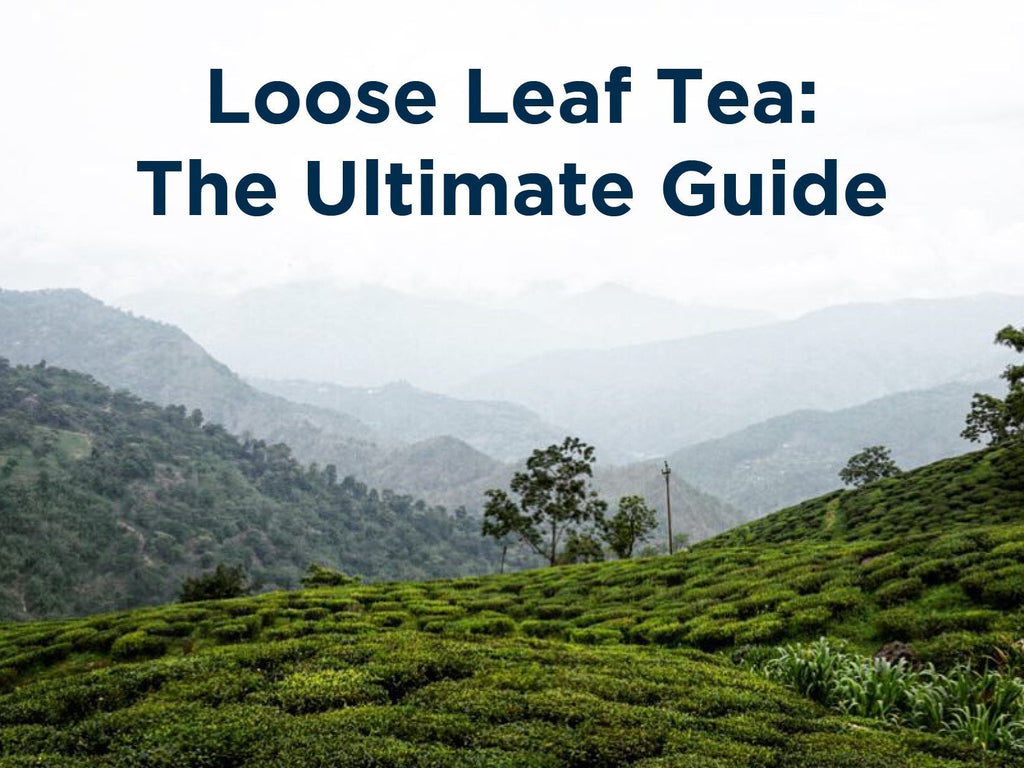
Loose Leaf Tea : The Ultimate Guide

Why loose leaf tea?
- Better taste – typically tea bags don’t contain the same quality of tea that you’ll find in loose leaf tea. Loose leaf tea features whole leaves, which produce the best flavour. Tea bags tend to hide the broken bits and dust which don’t produce the same results.
- It’s better for the environment – loose leaf tea doesn’t require the manufacturing of tea bags, for starters. But, did you know that most tea bags contain plastic? And we all know that plastic is bad for the environment.
- Personalisation – tea is a very personal thing, some people prefer it stronger and others have an extra small or large mug. Loose leaf tea allows you to get the perfect flavour for you. It’s better to add more tea (which you can’t do with a tea bag), than it is to brew your tea for too long, for example.
- Aesthetics – watching a jasmine or black dragon pearl can be quite satisfying. There’s also a ritualistic or mindfulness element to brewing loose leaf tea for a lot of people.

What types of loose leaf tea are there?
Black tea
Our favourite loose leaf black teas include:
Green tea
Oolong tea
White tea
Yellow tea

Dark tea
What about decaf loose leaf tea?

How to brew loose leaf tea
One of the common misconceptions about loose leaf tea is that it’s more work. If you’re used to chucking a bag of tea into a cup and pouring some water over, then perhaps it’s a little different. But we promise you, it’s really not that much work – and the results are worth it!
If you stick with loose leaf tea long enough to create a habit, we’re sure you’ll never look back. According to scientists, it takes an average of 66 days to form a new habit. So, why not try 66 days of loose leaf tea?!
Here at Team Tea, we like to talk about the 4 dimensions of the perfect cup! We’ll give you a quick summary here:
- Water – fully empty your kettle before each use, and make sure to use filtered water.
- Temperature – check the correct temperature for your tea. Different teas like different temperatures – we include guides with each of our teas.
- Tea – use the correct amount of tea. This varies from tea-to-tea, person-to-person. We recommend an amount for each of our teas, but get creative and see what works for you.
- Time – it really is the fourth dimension! Time how long you brew for, then remove the leaves completely from the water. Brewing for too long could spoil the taste and make it bitter. As with the third dimension, this can be a personal preference, so try out our recommendation and experiment.
How to store tea
Storing tea in the correct way is pretty straightforward and can help keep your tea at its best. The last thing you want is a mediocre cup of tea because you kept it in the wrong place!
Here’s our top 5 tips on how to appropriately store loose leaf tea:
- Away from light – keep it in a cupboard or opaque container.
- Away from humidity – use an airtight container and only use a dry spoon to measure it out.
- Away from strong odours – tea is very good at absorbing flavours, so don’t store different flavoured teas with each other. Those flavoured teas and herbal infusions won’t do your other teas any favours!
- In a cool place (but not the freezer) – extreme changes in temperature can affect the moisture levels in tea. In a cupboard, or on a kitchen work surface away from sunlight is fine.
- Check the best before date – properly stored tea will last a long time. However, the more aromatic the tea, the quicker it will need to be drunk.
What are the health benefits of tea?
Let’s get the disclaimers out of the way: we’re not health experts. However, there are some health benefits that we can talk about, thanks to the Tea Advisory Panel. They’re an independent body of doctors and dieticians, set up to answer questions about health and hydration when it comes to tea.
Thanks to the Tea Advisory Panel’s research, here’s a list of interesting facts and health benefits, that’s backed up by their research:
- It’s the most widely drunk liquid after water and is actually just as hydrating as water (without adding things, such as milk and sugar).
- Tea contains polyphenols. Polyphenols act as antioxidants in the body and fight free radicals. The polyphenols in tea are catechins, and the most powerful at stopping free radical damage is epigallocatechin gallate (EGCG), a unique compound found in plants.
- Tea contains caffeine which is a stimulant. The human body absorbs caffeine from tea slower than caffeine from coffee. Tea contains L-Theanine (an amino acid) which keeps the brain calm whilst caffeine wakes us up. This means that caffeine in tea doesn’t result in the same rush and crash that you get with coffee, which doesn’t contain this amino acid. Caffeine in tea affects the central nervous system rather than our circulation (as with coffee) so you don’t get the jitters.
- L-Theanine is an amino acid that reduces physical and mental stress and helps to keep us calm. It exists in only 3 plants: tea, bay bolete mushrooms, and guayusa.
- It is completely natural, as well as calorie and sugar free.
- Tea contains trace elements and minerals from the soil in which it is grown. This includes manganese, zinc, folic acid, potassium and fluoride.
A lot of the research into the health benefits of tea has been conducted in Japan, where people predominantly drink green tea. Hence the research has been conducted on green tea.
This research is now being replicated on black teas and, as you would expect with them being the same plant, the health benefits are largely the same. There are small differences in research results between the types of tea, but they’re comparable to the differences caused by the age of the plant, or the water temperature you use when brewing.
So, which is the healthiest tea? All of them, as long as you don’t add milk or sugar!
How ethical is our tea?
As with any industry, there are a lot of ethical considerations when choosing a tea, or tea supplier. This is a topic that we’ve been meaning to talk more about for a while now, so you can expect a more lengthy article to address the different points in the near future.
Here’s what we can address right now though…
All of the importers we use are members of the Ethical Tea Partnership (ETP). They work on far-reaching programmes with real impact. This means long-term change programmes that are designed to improve the lives of workers, farmers, their families and communities. It’s about improving incomes, empowering women to be more independent, improving health and nutrition in tea communities. You can find out more on ETP’s website.
ETP also works with tea growing communities to deal with, and become more resilient to, climate change. As well as working with the ETP, the environmental side of things is an area that we can have a direct impact on through our packaging.
We’ve worked hard to ensure that our packaging is as environmentally friendly as it can be, whilst still being food-safe (a legal requirement). This means that all our packaging is recyclable or biodegradable.
We use cardboard boxes, along with paper packing tape and eco-flo packaging fill (a.k.a. packing peanuts), which is made from plant starch and 100% biodegradable. Our labels are also printed using uncoated paper.
A brief history of tea
Tea is indigenous to the Himalayan Corridor, an area covering Southern China (Yunnan Province), Northern Vietnam, Northern Laos, Myanmar and East India (Assam).
The history of tea being made into a drink has some historical origins, as well as some mythological ones! We’ll start with the myths and legends.
The legend
According to legend, tea was first discovered by accident in 2737BC, by Chinese emperor Shennong. He liked drinking water that had been boiled to ensure it was clean. One day, while one of his servants boiled his water, the leaf of a wild tea plant fell into the water. This went unnoticed until the emperor tasted it and found it very pleasant – thus, tea (or cha) was born.
There’s also a slightly more gruesome legend, originating in India, rather than China. Bodhidharma, the Buddhist priest credited with bringing Buddhism to China, was said to have spent 9 years facing a cave wall in meditation. Furious that he was unable to stay awake, he ripped off his own eyelids. Upon falling to the ground, they became tea plants and were later used by monks who used tea’s stimulating properties to aid meditation.
The history
The exact time that tea became a drink isn’t known, but the legends we’ve just talked about may not be far wrong with their timeline. Ancient texts talk about tea being used for all kinds of purposes. Primarily, it seems to have a place in history as a medicinal drink.
Once the 2nd century AD hit, tea started to be traded out of China, along famous trade routes – the Silk Road to the West and the Tea Horse Road leading to Tibet.
It wasn’t until the early 17th century that tea reached Europe. So, while tea feels like an important part of our history here in the UK, we’ve only actually been drinking it for a few hundred years. That pales in comparison to the thousands of years it’s been present in other cultures!
Tea producing countries
Tea is now grown in over 80 countries around the world. All the UK’s tea used to come from China, before we started importing from India, and now over 50% of the tea drunk in the UK is grown in Kenya.
Kenya’s equatorial climate, with its lack of seasons, allows tea to be harvested all year round. This creates a stable supply for the UK’s tea bag industry.
Specialist teas, however, like our loose leaf teas, originate from more seasonal climates. They’re often grown at altitude, where the slower growth and differences in environmental factors result in interesting flavours.
Here’s a quick rundown on famous tea growing regions:
- India
- Sri Lanka
- Taiwan
- China
- Japan
- Africa
- Nepal
- Korea
- Vietnam
And some emerging tea regions, featuring some surprising entries:
- Georgia
- South America
- USA
- Australia
- UK
- Mauritius
- Azores
- France
Thank you for reading! Is there anything we’ve missed? Let us know in the comments and we’ll be sure to get back to you. If you enjoyed this article, please bookmark it for later, save on Pinterest or share on Facebook and Twitter!



















